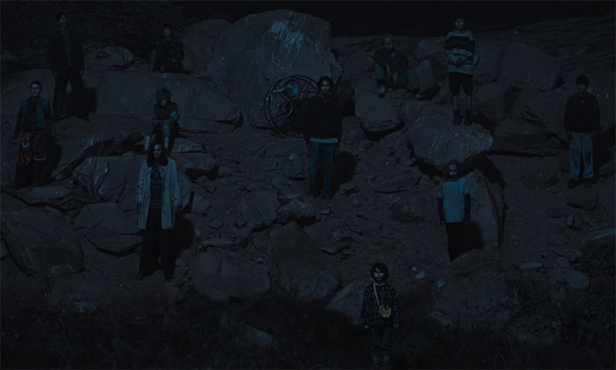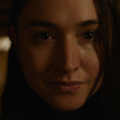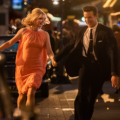Writer/director Barnaby Clay’s feature debut opens with a peculiar pairing of scenes that set the tone for what is to come. In the first a toddler, naked but for his nappy and absolutely filthy, walks in the desert chewing on a piece of meat that gradually comes into focus as a severed human finger. In the second, a car, shot wide from above, drives along a dusty road until stopping and parking at its conspicuously tapered end – and the high angle of the shot makes it clear that this desert track comes with the distinctive shape of a spermatozoon. Indeed, in keeping with its title, The Seeding is concerned with the cycles and rituals of life’s procreative processes – in a barren landscape full of feral boys.
The driver of the car (Scott Haze) – whose name we will later learn is Wyndham Alan Stone – is in this arid canyon to capture a solar eclipse on his high-end camera. After running into a strange young boy (Charlie Avink) who claims to be lost, Stone himself gets turned around and dehydrated. Lured in the night by the sound – and then sight – of a woman (Kate Lyn Sheil), unnamed in the film but listed in the closing credits as Alina, who is singing to herself by her cabin in a rocky clearing below, Stone climbs a ladder down the cliff face to ask her for help, collapses in exhaustion, and wakes the next morning to discover that the ladder is gone, and there is no way for either Alina or him to escape the sheer walls of this hole – and when Stone tries to scale the cliff, a rowdy gang of young men above makes him lose his balance and injure his leg in the subsequent fall. Now, like the wounded bird that Alina keeps in a cage until it may heal, Stone is trapped.
“It’s kind of a microcosm down here,” Stone will later say of the rocky prison that he shares with Alina, “A smaller world existing within a much larger one.” Sure enough, as he negotiates his relationship with the taciturn Alina and learns how to survive within the narrow confines of his new home way off-grid, he must also contemplate big questions about what it is that he truly wants and values in his existence, what freedom actually means, and whether there is more to life beyond our basic biological function and the Darwinian demands of survival. For this little universe contains everything that a person needs: food, clothing, shelter, love, family, even ground fertile enough to seed new life. As time passes, this man who takes pride in his autonomy and independence starts ever so slowly, over many moons, to reconcile himself to being tied down to someone else, and giving himself over to the next generation.
The Seeding opens with an eclipse – a heavenly event in which the paths of sun and moon, often figured in myth as masculine and feminine, intersect to bring an ominous darkness before the light can return and life can be renewed. While the film itself is full of searing desert sunlight, its narrative is measured (in formal chapter headings) by the passages of the moon, recalibrating Stone’s time inside this cavernous feminine space (its walls graffitied with illustrations of a snake-like woman refreshing herself by sloughing off her skin) in accordance with a distinctly menstrual cycle. For in this microcosmic zone, the movements of individual and astronomical bodies collapse into one, even as, further confounding the cellular and the celestial, there are occasional cuts to abstract graphic representations of phenomena that might be occurring at either a molecular or a galactic level. As above, so below…
This updated reimagining of Hiroshi Teshigahara’s Woman of the Dunes (1964) cruelly allegorises entrapment and emancipation (of sorts), reducing the human condition to its most essential elements. Cinematographer Robert Leitzell shoots the sandstone pit from every angle, capturing the ritualised rhythms that Stone comes, not entirely willingly, to observe with his fellow inmate. Meanwhile Tristan Bechet’s often discordant score makes everything resonate with tension and foreboding – and Sheil, whose mere presence in a project these days serves to promise something idiosyncratic and unnerving, brings a quiet menace to her mysterious matriarch, calling all the shots without ever seeming to exercise any authority. After all, she too is trapped.
In The Seeding, the horror is ultimately existential, and the thrills are rooted as much in infernal abstractions as in lost boys‘ jeering threats. For here Clay is setting out our place in our bodies, in the company of other people, and indeed in the universe, all figured as a hole in which we can easily become stuck. This bleakly-mannered calling card sows seeds that will take root in the viewer’s mind and keep growing there long after the film has reached its bitter end.
The Seeding had its world première at Tribeca Film Festival




